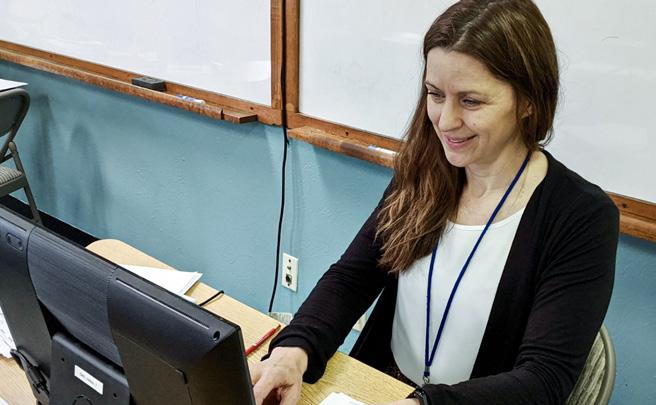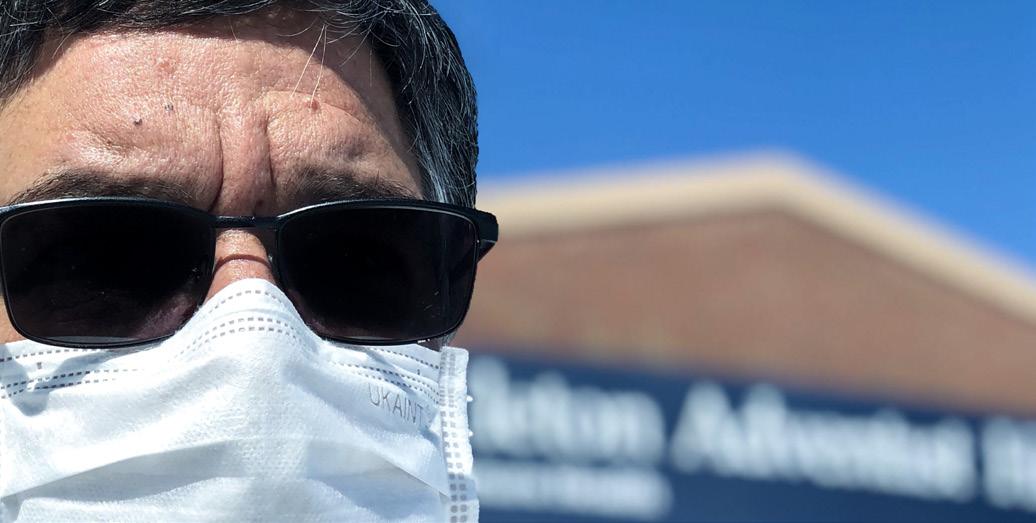
8 minute read
ROCKY MOUNTAIN
Hospice Chaplaincy in the Age of COVID-19
Normally, I spend my days driving to different nursing facilities and homes, visiting patients and/or their families. I carry a caseload of 35-40 patients, 100 percent of whom are dying. Their families are grieving and trying to figure out how to care for their parent, spouse or child who may have months or days to live. The patient may know they are dying, but most don’t even realize they are sick, as most have some level of cognitive decline.
Some do not recognize their family. This makes the grieving process harder for families. They sometimes spend months in a steady state of anticipatory grief, and it is my job to sit with the family as they walk through that. Often, the best we can do is help them to not suffer and grieve alone.
The same is true for patients. It may be about listening to them as they ask questions like, “I’m 97. Why won’t God let me die?” But most often, I’m another face who came to visit, and in their minds in that moment, I’m the only person who came to visit them, because they can’t remember that their family comes every day. They believe they’ve been abandoned and no one loves them enough to visit.
My greatest tools aren’t my words, but instead my hands that hold theirs, my arms that give hugs, and my warm body that sits in the room with them when they are no longer able to form words.
And then COVID-19 took away most of my tools. Zoom and other tele-health platforms can be used, but most of my patients don’t remember how phones work, and they wonder who that
Staff meetings, administrative meetings and board meetings are all virtual. I eat lunch by myself and sit in front of a computer by myself.
Keeping students on task is hard. Some students thrive without supervision, others don’t. Just like the students, some parents are succeeding, and others are not.
A Day in the Life of a Teacher During COVID-19
Istill dress like a professional, drive to my office, start school at 8 am, have devotions and talk with my students about the day’s assignments. The difference, though, is I’m the only one in my classroom. I meet with my students through Zoom.
As a coach to my students, I feel like I have one hand tied behind my back. Normally, I’m in the ring with them, cheering them on. Online learning takes a lot of self-discipline. Add a whole house of distractions, and who wouldn’t have a hard time focusing?
I do like the fact that I meet with every one of my students throughout the day individually. We go over anything they need help with. I get to see family pets, hear their siblings in the background, and once in a while their mom or dad might pop up on the screen.
weird voice is talking to them through the plastic thing in their hand.
Families can’t see their loved ones anymore. But therein lies something important. Before, I was sitting with people in their experience, but now I am talking with people as I share their experience. And that subtle difference is infinitely important. I sit in my house, just like the families. I call on the phone because I can’t leave my house to see people. And we talk about what it’s like to be isolated from the people we care about and love.
The difference is, when this is done I get to see my friends and family again. But for many families, the next time they will be allowed to see their loved one is when that person dies. This has opened up a new and more efficient
I also like the fact that my day is more flexible. During my lunch break, I can go for a walk. If I need to meet with a parent between classes, that is no problem.
COVID-19 has brought with it flexibility and creative thinking. I’ve been stretched in ways I never could have imagined, and so have my students. All in all, I think we have done pretty well. I am proud of myself, my staff and my students.
My students and I also agree that COVID-19 has given us more time with God and our families, and this is something I count as a priceless blessing. Yes, we’re in the middle of a storm, but we get to be in the boat with the Master Teacher.
Michelle Velbis is principal of Springs Adventist Academy in Colorado Springs, Colorado.

avenue for helping families process their loss.
Before, I would have to work hard to get some families to engage the reality of fatigue and loss. But now, it hits them immediately. When I call them, they start talking about isolation, then they speak of how hard it is to know their loved one is alone. But then the truth comes out. The loved one with the cognitive decline hasn’t noticed a difference during quarantine, but the family has.
Now, the family recognizes what that loved one must feel like all the time. Now the family fears they will never see their loved one again this side of death. And now they have no ability to hide from the reality.
As a result, my work is strangely more intimate. We start from a shared perspective. I am present with them in a new way. There is less physical presence, but there is shared emotional presence. The reality they have denied for so long becomes real, and we confront it together. We step into it and walk through it. And whether we pray together for strength or I listen as they rage against an unfair God, we keep moving forward in spite of fear, loss and regret.
We move forward together, sharing in each other’s wisdom, companionable in the shared reality, all while seated on our comfy couches wrapped in our soft pajamas.
Tony Hunter is a pastor and hospice chaplain working for Elevation Hospice in Northern Colorado.
Recognizing Our Healthcare Workers
Laughter, joy, food and community—key components of what makes us human—tap into areas of our lives that are communal and give us a sense of togetherness. And that’s why I hate COVID-19.
As chaplains, most of our ministry is simply being present. Many times, we sit quietly next to a family member or a dying patient with the only gift we have to offer: presence. That is why these times are so difficult for patients, families, nurses, doctors and chaplains. The one thing all of us can do well has been taken away from us.
I’ve said many times that togetherness has nothing to do with proximity, but it sure helps. COVID-19 has taken from us the ability to hug someone who just lost their spouse, to shake the hand of a first-time dad, to high-five a nurse leaving the hospital after a 12-hour shift. Instead we’ve had to learn how to keep a 6-foot radius around other humans, to smile with our eyes because the rest of our bodies are covered with protective equipment, to look Dany Hernandez

in the eyes of a daughter and say, “I’m sorry you can’t see your mom.”
We’ve been forced to watch a spouse of someone passing away in the ICU who is unable to be in the room, hands on the glass door, tears running down her face while she talks, hoping her voice penetrates the double-pane glass and the unconscious state of her husband, assuring him she is there with him. This virus has forced us to take on the emotional stress of family members by sitting in their place next to the patient, by speaking the final words they hear on behalf of the family, by holding a stranger’s hand until their last breath because it was the only hand allowed in the room.
There’s a strange stillness. Our staffing needs have changed, and what used to be a busy unit now sits dimly lit and quiet. At the same time, our ICU—just a floor away— is the hub of frantic activity.
There’s a sense of anonymity when we wear headgear and masks. The identities and uniqueness of our caregivers erodes by blending into the common landscape of skyblue scrubs. We have to wear name tags so our coworkers and friends know who we are.
Our associates need to be recognized for standing every day between the dead and the living, between the sick and the healthy, regardless of consequences. They chose to put their lives on the line so other people—in spite of race, creed or background—may have life. What they need is individuals from every walk of life to lift them up in prayer, asking for strength, courage, peace and serenity.
Now, more than ever before, we are standing next to patients in the place of family. Nurses, palliative care and chaplains are sharing tears with one another and experiencing grief on behalf of loved ones.
Humans need hugs, and COVID-19 has taken those away. Community and presence are both part of the healing process, and now we’ve been forced to incorporate those into our plan of care without the ability to be next to one another.
As frustrating as it is, I have to remind myself that love always causes pain. Suffering and grief will always be a part of our lives in this world. And that our call, even after COVID-19, will continue to be difficult and challenging. I’m honored to be part of such an amazing group of people.










